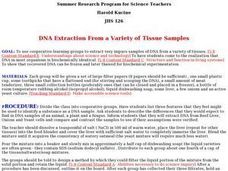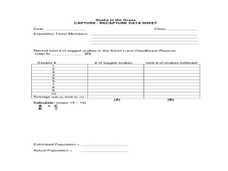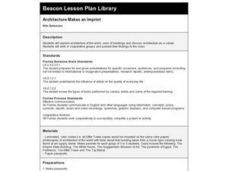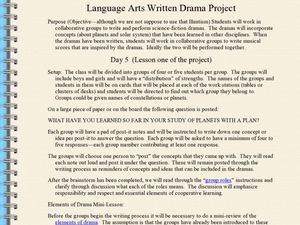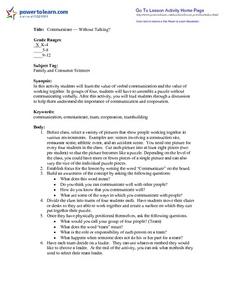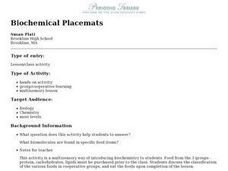Curated OER
STONEHENGE
Students work in cooperative groups to create a theory about the origin of Stonehenge. Each member of the group has a specific role, responsibilities and tasks. The group work can be implemented as a scaffolding technique.
Curated OER
DNA Extraction From a Variety of Tissue Samples
Pupils, working in cooperative groups, extract very impure samples of DNA from a number of tissue samples. They determine how the samples can be preserved and how they are similar.
Curated OER
Is it Really Winter in Australia? It is June!
The purpose of this activity is to determine how the location of a place on the Earth (hemisphere) determines what season that place is experiencing relative to the Sun's rays. Day one the students will be introduced to the terms...
Curated OER
How Much Do We SPend For Electricity?
Students investigate the concept of energy and focus upon the usage and the cost associated with it. They conduct research using a variety of resources while working in cooperative groups. Students graph the usage of energy as estimates...
Science 4 Inquiry
Expanding the Universe
When Einstein first heard the theory of the expanding universe, he dismissed it as bad physics. Now scholars learn about the theory and how scientists prove it has merit. Through a hands-on simulation and videos, class members measure...
Curated OER
Deep Blue Sea
Elementary schoolers identify the ocean floor in a geological sense. They create a presentation that highlights the key features of the ocean floor. This terrific lesson plan has excellent streaming video segments embedded in it, and the...
Curated OER
Life Cycle of a Butterfly: Kidspiration
Second graders view a video about butterflies and recall its life cycle. They will also complete a Kidspiration slide show to illustrate the life cycle of a butterfly and study a word list of butterfly vocabulary to include in their...
Curated OER
What's Your Genus? Scientific Classification and the VT
Students learn about binomial nomenclature, the scientific system of classification. In this scientific classification lesson plan, students work cooperatively to complete a binomial scavenger hunt using the internet and a Visual...
Curated OER
Snake in the Grass: Capture/Recapture Activity
Learners estimate the total number of species in Ecuador using the capture/recapture method. They collect data about each species and act as members of a science expedition to determine the total number of species by using mathematical...
Curated OER
Explaining the Bill of Rights
Students define the terms Bill of Rights and amendment. They successfully explain the meaning of each amendment of the Bill of Rights. Students work together in cooperative groups.
Curated OER
Architecture Makes An Imprint
Fifth graders explore architecture of the world, uses of buildings and discuss architecture as a career. They work in cooperative groups and present their findings to the class. This lesson can be expanded to include a printmaking lesson.
Curated OER
Close Observation: Coins
Integrate math, science, and speaking/listening with a collaborative hands-on activity. Each group works with a single penny, examining it with the naked eye and recording observations. Repeat using magnifying glasses. Then repeat with a...
Curated OER
Language Arts: Ode to the Ordinary
Eighth graders select ordinary objects, determine their uses, and write poems about them. Once they select an object, they create a web about its uses to serve as an outline. Once they have written their own odes, 8th graders meet in...
Curated OER
Put Your Truss in Building Bridges
Students apply abstract concepts, such as stress, fulcrums, the law of gravity, and the strength of different geometric shapes. Groups of student contractors operate simulated architectural firms to create strong, economical bridges.
Curated OER
Rollin' On
Third graders investigate the effects of gravity on the motion of a marble on an inclined plane and a declined plane. They work in small cooperative groups to predict and explain outcomes.
Curated OER
Where Have All the Wetlands Gone?
Students investigate the wetlands. In this environmental conservation lesson, students discuss the characteristics of wetlands and identify their location. Students work in cooperative groups to complete a handout.
Curated OER
Language Arts Written Drama Project: Creationism
High schoolers create and perform science fiction drams based upon their knowledge of the solar system. For this solar system lesson students work in cooperative groups to create a short play and will also score the play.
Curated OER
Wish You Were Here - Research Conditions on Mars
Students research conditions on Mars, then create a travel brochure or presentation to attract tourists. They work in cooperative groups. Each member is assigned a different role and contribute specific information to the group's brochure.
Curated OER
Land Biomes Research and Presentation
Fifth graders work in cooperative groups to research an assigned land biome using various sources. Groups create either a book or a PowerPoint presentation of their assigned land biome.
Curated OER
Communicate - Without Talking?
Students discuss and define communication and identify different ways of communicating with people. Students then practice team building and non-verbal communication skills as they work silently in small teams to put puzzles together.
Curated OER
Living On Earth
Students discover the many different animals within various habitats and discover how each individual species interacts with its particular environment. Through charting different animals and their distinct habitat and matching animals...
Curated OER
Magnets
Second graders participate in a teacher demonstration of the polarity of magnets. They observe how magnets repel and attract items before drawing their observations on worksheets. They manipulate the donut magnets, discuss their action...
Curated OER
Blue Genes: Affect Your Life!
Students, in groups, research, analyze and synthesize information on genetic diseases. After watching a video on genetics, groups perform research on a variety of genetic diseases and present their findings to the class.
Curated OER
Biochemical Placemats
Students group various foods according to whether they are proteins, carbohydrates, or lipids. This activity is a multisensory way of introducing students to biochemistry. Students also learn how icons represent the molecular composition...

